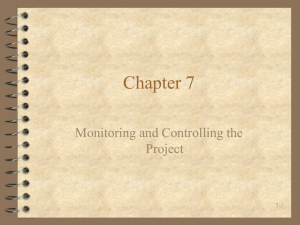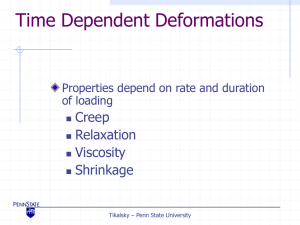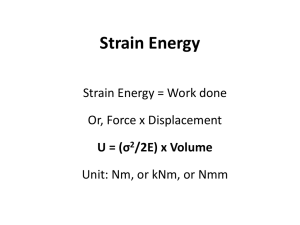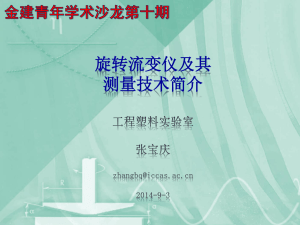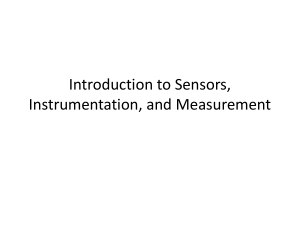ViscoLecture - Rose
advertisement
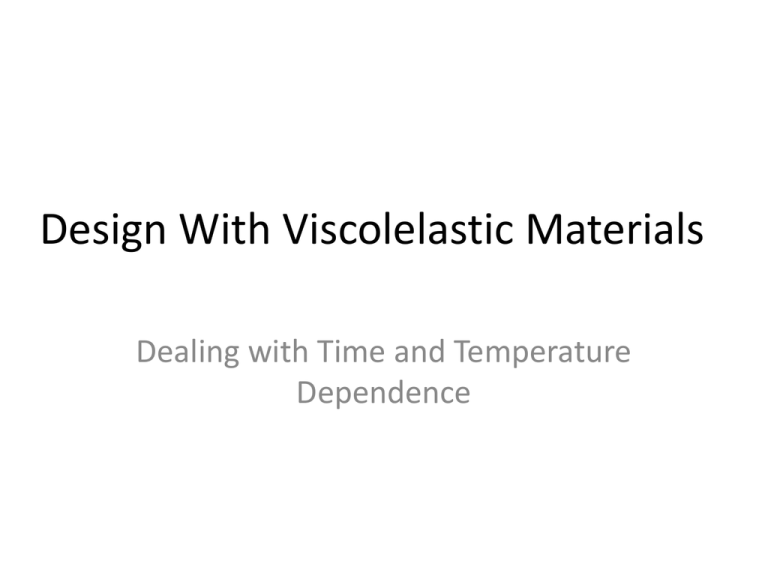
Design With Viscolelastic Materials Dealing with Time and Temperature Dependence Design with Viscoelastic Materials • • • • • How are Properties Defined? Introduction to Viscoelasticity Strain Rate and Temperature Effects Simple Material Models Empirical Methods 2 Learning Objectives Upon completion of this session, participants will be able to: 1. Describe how temperature and loading rate affect mechanical properties. 2. Define creep and stress relaxation and describe design situations for each. 3. Apply manufacturer’s data to design for applications in both short term and long term loading. 4. Relate data from creep curves and isochronous stress strain curves. 5. Apply snap fit design guidelines. 3 Review • Basic definitions: thermoplastic, thermoset, elastomer. • Let’s talk about the kind of mechanical behavior seen in polymers. 1. Strength 2. Stiffness 3. Ductility • Factors which can determine the strength of a polymer. 4 Tensile Properties for Polymers Polymer Yield Strength is defined by the first peak on the stress strain diagram, not the 0.2% offset used for metals. 5 Strength is: • A measure of stress (load per unit area with units of ksi or MPa) • Yield Strength (1st peak in uniaxial tension test) • Ultimate Tensile Strength (Highest stress in uniaxial tension test) 6 Stiffness is: • Young’s Modulus (Elastic Modulus), E with units of ksi or MPa • The slope of the straight line part of the stressstrain curve • The ratio of stress to strain (where strain is the change in length with respect to the original length, ΔL/L0) E 7 Ductility is: • % Elongation (with units of in/in or mm/mm) • The permanent percentage change on length after fracture (from a uniaxial tension test) ΔL/L 8 Mechanical Properties Stress-strain behavior of polymers brittle polymer FS of polymer ca. 10% that of metals plastic elastomer elastic modulus – less than metal Strains – deformations > 1000% possible (for metals, maximum strain ca. 10% or less) Adapted from Fig. 15.1, Callister 7e. 9 Question 1. Two cantilevered beams of identical geometry have identical loads applied at their free ends. After removal of the loads, both beams return to their original position. A P B P While the load is applied Beam A deflects twice as much as Beam B. Thus: i) The Strength of Beam A is a) Higher than Beam B b) Lower than Beam B c) Can’t be determined with respect to Beam B from this information ii) The Stiffness of Beam B is a) Higher than Beam B b) Lower than Beam B c) Can’t be determined with respect to Beam B from this information iii) The Ductility of Beam B is a) Higher than Beam B b) Lower than Beam B c) Can’t be determined with respect to Beam B from this information 10 Introduction to Viscoelasticity 1. Mechanical properties depend on Temperature 2. Mechanical properties depend on Strain Rate 3. Creep (progressive change in strain at constant stress) 4. Stress Relaxation (progressive change in strain at constant strain) 5. Hysteresis (significant difference in load and unload stress-strain curves) 11 Effect of Temperature on Strength As Temperature Increases • Strength Decreases • Stiffness Decreases • Ductility Increases “Celanese Nylon 6/6 Processing and Troubleshooting Guide” by Ticona 12 Time Temp for Delrin (Strain Rate) http://www2.dupont.com/Plasti cs/en_US/assets/downloads/desi gn/230323c.pdf 13 Effects of Strain Rate and Temperature stress Increasing strain rate Increasing temp strain 14 Time Temp for Delrin (Strain Rate and Temp) http://www2.dupont.com/Plasti cs/en_US/assets/downloads/desi gn/230323c.pdf 15 Time Temp Dependence • Plastic deformation of polymers involves chain uncoiling and chain sliding • Increasing temperature increases relative space between chains and makes uncoiling easier. • Slowing the strain rate means there is more time for chain reconfiguration. 16 Questions 1. As you increase the temperature of a polymer, you expect i) The yield strength to (increase, decrease, stay the same) ii) The Young’s Modulus (stiffness) to (increase, decrease, stay the same) iii) The % Elongation (ductility) to (increase, decrease, stay the same) 2. As you increase the strain rate (faster loading) of a polymer, you expect i) The yield strength to (increase, decrease, stay the same) ii) The Young’s Modulus (stiffness) to (increase, decrease, stay the same) iii) The % Elongation (ductility) to (increase, decrease, stay the same) 17 Creep • Take a tension specimen made from a polymer and apply a constant stress. • We observe Creep: Progressive strain (deformation) over time at constant stress (load), usually at high temperatures 18 Creep Test • We instantly load with constant stress for a certain time, and instantly unload. Note that both linear elastic and viscous fluid behaviors are present. Note that there seems to be some residual strain at the end, i.e. the material does not completely recover. There is both elasticity and plasticity. 19 Load-Unload Cycle in Nylon “Zytel/Minlon Design Guide” DuPont 20 Creep of PEEK “PEEK Properties Guide” Victrex 21 Stress Relaxation Think of a polymer specimen loaded with a constant strain. Note that both linear elastic and viscous fluid behaviors are present. Note that there seems to be some residual stress at the end, i.e. the material does not completely recover. There is both elasticity and plasticity. Stress Relaxation: Progressive loss of stress (load) over time under constant strain (deformation), usually at high temperatures 23 Stress Relaxation of Delrin http://www2.dupont.com/Plasti cs/en_US/assets/downloads/desi gn/230323c.pdf 24 Questions 1. A plastic bolt is used to hold two halves of a housing together. The loading in the bolt is best described as a) Creep b) Stress Relaxation 2. A gasket is compressed between the two halves of the housing described in the previous question. The loading on the gasket is best described as b) Creep b) Stress Relaxation 3. A cantilevered snap fit arm does not completely straighten after installation. The lading on the arm is best described as a) Creep b) Stress Relaxation 26 Effect of Temperature-Glass Transition Or why does Garden Hose behave the way it does? Vinyl Garden hose can go from flexible to rigid as the seasons change. 28 Glass Transition Temperature Many amorphous materials show a change in behavior as the material changes from viscous to rigid. For polymers, the rigid behavior below Tg results from the inability of the chains to move easily (chains have insufficient free volume to coil and uncoil). 29 Melting Temperature For polymers, Tmelt usually refers to the transition from semicrystalline to fully amorphous rather than a solid to liquid transformation. Thus, a melting temperature may not be reported for an amorphous polymer, and some polymers may be both liquid and crystalline. (Some companies report a crystalline temperature and a melting temperature.) 30 Melting vs. Glass Transition Temp. What factors affect Tm and Tg? • • • Both Tm and Tg increase with increasing chain stiffness Chain stiffness increased by 1. Bulky sidegroups 2. Polar groups or sidegroups 3. Double bonds or aromatic chain groups Regularity – effects Tm only Adapted from Fig. 15.18, Callister 7e. 31 Tg and Tm 32 Questions 1. As we increase the temperature of a polymer from below the glass transition temperature to above the glass transition temperature we expect the stiffness a. To increase by orders of magnitude b. To increase slightly c. To decrease by orders of magnitude d. To decrease slightly e. To remain the same 2. Below the glass transition temperature, molecular chains a. Can’t coil and uncoil b. Can coil and uncoil but with significant difficulty c. Can easily coil and uncoil 33 Hysteresis • Polymers often don’t load and unload on the same line on the stress-strain curve. • The difference in areas under those curves represents energy loss (often to heat). • This means that polymers can have inherent energy damping. • This means plastic springs may not be as good an idea as plastic dampers. 34 Hysteresis in Delrin “Delrin Design Guide” DuPont 36 Time Dependent Response can be Modeled • Maxwell Model • Kelvin-Voight Model • 4 Element Model 37 Maxwell Model • Here is an alternative to the simple spring model of linear elasticity. Add a damper. This gives what is called as the Maxwell model. In the limit, it’s a fluid! strain stress Creep not too good! time Stress relaxation is not bad time 38 Kelvin-Voigt Model • Try putting the spring and damper in series This gives the Kelvin-Voigt model. In the limit, it’s a solid! strain stress time Doesn’t really show stress relaxation! time 39 4 Element Model Standard Linear Solid • Further improvement is possible. stress Shows both creep and stress relaxation! strain time 40 Stress Strain Relationships • We can get stress from strain history and strain form stress history through the following heriditary relationships. K is creep modulus, and F is the relaxation modulus. 41 Examples of These Time Dependent Moduli Material Creep Modulus Relaxation Modulus Maxwell Kelvin Voigt Standard Linear Solid 1 1 E t H ( t ) E t 1 1 e 1 1 1 ER E e H (t ) t e H (t ) E t H (t ) (t ) E H (t ) E R 1 1 t e H (t ) H(t) is the unit step function. (t) is the Dirac delta function 42 More on the material models • Testing needs to be done to fit the parameters of the model to the behavior of an actual material. • Note the fact that the history of the material must be recorded to be able to complete the calculations. • Some additional complexity. The parameters in the creep modulus and relaxation modulus are 1. Temperature Dependent 2. Strain Rate Dependent 43 Summary Polymers exhibit: • Great sensitivity to temperature. • Great sensitivity to strain rate. • Very complex behavior Model parameters are difficult to determine – Therefore we will use an empirical approach. 44 Without Effective Math Models we will rely on Manufacturers Data to make Design Decisions • What are the limitations of Material Data Sheets? • What do the polymer companies recommend? • How do companies report time and temperature dependent properties? • Designing using Creep information. 45 Empirical approach • Use published information on behavior Suppliers data sheets Suppliers creep curves 46 What can we learn from Supplier Data Sheets Polymer parts in service will generally have lower material property values Strength, Stiffness, and Impact Energy than the ones listed in the Supplier Data Sheet. 47 What are the problems for Strength and Stiffness values? • Tested at a single temperature (usually room temp) • Tested at a single strain rate. • Polymer flow is in the direction of loading (advantage of molecular alignment) • Effects of colorants and other additives 48 Impact data may thickness sensitive. Polycarbonate Resin – Product Brochure, Sabic 49 Impact Data may Depend on Notch Radius Delrin Design Guide, DuPont 50 Polymer Flow Affects Properties http://www.ides.com/articles/design/2006/sepe_07.asp 51 What does the Designer Do? From Lavengood and Silver in “Interpreting supplier Data Sheets”, ASM Engineered Material Handbook, Polymers: Tensile and Flexural moduli “may be used directly in design calculations for items that do not carry sustained loads and are not exposed to elevated temperatures or adverse environmental factors.” In other words, we can use the supplier data for a clean, dry, indoor application of primarily decorative function. 52 Company Recommendations General Design Principles for DuPont Engineering Polymers 53 Company Recommendations – Preliminary Design What safety factors do these numbers represent? Designing with Plastics, The Fundamentals - Ticona 54 What do Plastics Companies Recommend? • Checklists • Use of Creep Curves • Confirm by Testing 55 Checklist from Bayer http://www.bayermaterialsciencenafta.com/checklist/ 56 From the DuPont Checklist http://plastics.dupont.com/plastics/pdflit/americas/markets/H81079.pdf 57 DuPont Checklist-Mechanical http://plastics.dupont.com/plastics/pdflit/americas/markets/H81079.pdf 58 DuPont Checklist-Environment http://plastics.dupont.com/plastics/pdflit/americas/markets/H81079.pdf 59 Other DuPont Checklists Writing Meaningful Specifications A specification is intended to satisfy functional, aesthetic and economic requirements by controlling variations in the final product. The part must meet the complete set of requirements as prescribed in the specifications. The designers’ specifications should include: • Material brand name and grade, and generic name (e.g., Zytel® 101, 66 nylon) • Surface finish • Parting line location desired • Flash limitations • Permissible gating and weld line areas (away from critical stress points) • Locations where voids are intolerable • Allowable warpage • Tolerances • Color • Decorating considerations • Performance considerations General Design Principles for DuPont Engineering Polymers 60 DuPont Example General Design Principles for DuPont Engineering Polymers 61 Long Term Properties for Example General Design Principles for DuPont Engineering Polymers 62 General Design Principles for DuPont Engineering Polymers 63 General Design Principles for DuPont Engineering Polymers 64 General Design Principles for DuPont Engineering Polymers 65 How Do Companies Report Time and Temperature Dependent Properties? • • • • Creep Curves (Strain vs. Time) Isochronous Stress Strain Curves Creep Modulus (Modulus vs. Time) Stress Relaxation Curves (Stress vs. Time) All curves must contain information on: Stress, Strain, Time, Temperature 66 Data is usually taken in a creep test and replotted for the other graphs. Designing with Plastics, The Fundamentals - Ticona 67 Creep Curve Creep curves show the data as it was most likely measured, as strain vs. time for constant stress. “PEEK Properties Guide” Victrex 68 Isochronous Stress-Strain Curves Creep data is plotted as constant time (isochronous) stress vs strain curves at a given temperature http://bmsnafta-campusi.com/matdb/matdb.php 69 Creep Modulus vs. Time Creep Stress is divided by strain at a given time to determine a “Creep” modulus. http://bmsnafta-campusi.com/matdb/matdb.php 70 Exercise Confirm that the Creep Modulus Curve is a replotting of the Isochronous Stress-strain Curve. Use the data shown on the Isochronous curve for Apec 1745 polycarbonate to create the 15 Mpa line on the Creep Modulus plot for Apec 1745. 71 Stress Relaxation Curve Stress Relaxation should be tested under constant strain, but most reported results and replotted creep curves. http://www2.dupont.com/Plastics/en_US/assets/downloads/design/230323c.pdf 72 Designing with Celcon - Ticona Where do these ratios come from? Talk to the supplier. 73 Designing with Celcon - Ticona 74 A BASF Approach to Design A method described in BASF’s document, “Review of mathematical design methods for thermoplastic machine parts”, uses multiplied “efficiency factors” to account for the effects of long-term loading, temperature, or strain rate. These factors multiply together in a manner you may have seen before in fatigue design. 75 A BASF Approach to Design The design stress is the published strength, K, divided by the safety factor and the product of all the “efficiency factors”. 76 Suggested Safety factors 77 Efficiency factors As can be seen below, the efficiency factors can add 50 to 300% each to the safety factor, 78 Cumulative Effect of Factors If we start with a factor of safety of 3 on bending and buckling and have efficiency factors of 1.5 for sustained loading, 1.5 for dynamic loads, and 1.25 for temperature, we would have an effective Safety Factor of about 8. This is consistent with the preliminary design guidelines we saw earlier. 79 Snap Fits • Types of Snap Fits • Snap Fit Issues • Snap Fit Calculators 80 Types of Snap fit -Annular Snap Fit http://engr.bd.psu.edu/pkoch/plasticdesign/snap_design.htm 81 Types of Snap Fit - Cantilever Snap Fit http://engr.bd.psu.edu/pkoch/plasticdesign/snap_design.htm 82 Snap Fit Issues • Integral Fastener • Can be designed for disassembly • Snap fits represent an undercut that complicates molding • Snap fits that remain under load will stress relax 83 Eliminating Snap Fit Undercut http://engr.bd.psu.edu/pkoch/plasticdesign/snap_design.htm 84 Dealing with Snap Fit Undercut http://engr.bd.psu.edu/pkoch/plasticdesign/snap_design.htm 85 Snap Fit Calculators • Manufacturers have design guidelines • Type “Snap Fit Calculator” in to Google will get plenty of hits • Most are a modification of cantilever beam analysis 86 http://www.basf.com/businesses/plasticportal/pp_techRes_tools_snapfit_en.html 87 BASF Definition of Terms Snap-Fit Design Manual, BASF Plastics 88 Classical Beam Theory Snap-Fit Design Manual, BASF Plastics 89 “Improved” Method Snap-Fit Design Manual, BASF Plastics 90 BASF’s “Improved Canitlever Snap-Fit Design”. The Q factor accounts for the flexibility of the part. Note that Example 1 has the least flexibility, so the Q factor is close to a value of one. From: Snap-Fit Design Manual, BASF Plastics 91 Snap Fit - BASF Snap-Fit Design Manual, BASF Plastics 92 Snap-Fit Design Manual, BASF Plastics 93 Additional Sources Snap fit calculator from Engineer’s Edge www.engineersedge.com/ snap_fit_tapered.htm Snap fit Design excerpt from Paul E. Tres’ book http://engr.bd.psu.edu/pkoch/plasticdesign/snap_design.htm Annular Snap Fit article in Machine Design http://machinedesign.com/article/fundamentals-of-annularsnap-fit-joints-0106 94 Press Fit Issues • Initial stress could cause boss to crack • Boss may have weakening weld line • Continuous deflection and resultant stress could cause Cracking Stress Relaxation and reduced pull-out force 95 Boss with weld line support General Design Principles for DuPont Engineering Polymers 96 Loss of force in press fit When subjected to constant strain, the resulting stress in the plastics diminishes over time. Imagine a metal insert pressed into a boss. As time goes on, the plastic boss material grips the insert with less and less force. Eventually the insert may become too loose, resulting in a failed joint. http://www.bayermaterialsciencenafta.com/checklist/ 97 Questions 1. A snap fit in which the cantilever arm remains bent after installation a. Will maintain the same end force over time b. Will have an increasing end force over time c. Will have a decreasing end force over tim 2. If a metal pin is press fit into a plastic boss (circle all that are true) a. The pullout force ill decrease over time b. The boss may experience creep rupture c. When the pin is removed the hole will decrease in diameter over time, but probably not back to original diameter. 98
